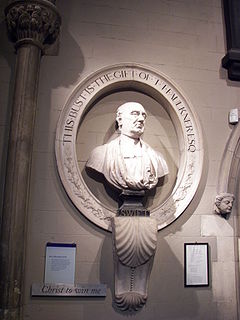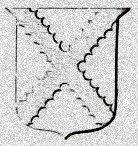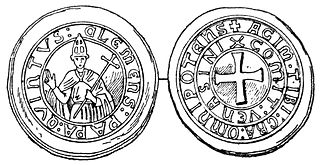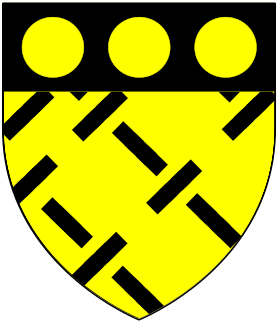Related Research Articles
William de Sancto Claro, or simply William Sinclair, was a 14th-century bishop of Dunkeld. He was the son of Amicia de Roskelyn and Sir William Sinclair, Baron of Roslin. He was the brother of Sir Henry Sinclair, baron of Roslin. After the death of Bishop Matthew de Crambeth in 1309, William was elected to the bishopric. The following year, on 24 February 1310, William was one of twelve Scottish bishops to swear fealty to King Robert the Brus. However, king Edward II of England had his own candidate in mind, John de Leck. William went to the Holy See, where his election was contested by the said John. The diocese of Dunkeld lay vacant for three years. Pope Clement V appointed Cardinal James, cardinal deacon of St George in Velabro, to judge the issue. However, the issue was more or less resolved when, on 22 May 1311, John de Leck was promoted to the Archbishopric of Dublin. When John de Leck took over the see of Dublin on 20 July, he retired from the dispute. The pope then declared William's election canonical, and sent him to Cardinal Berengar Fredol, bishop of Tusculum, in order to be consecrated. On 3 February 1313 king Edward II issued a safe-conduct to William, clearly indicating that the bishop was planning to arrive in England on his way back to Scotland, however Edward demanded cooperation in political matters as a condition. William became a frequent witness to King Robert's charters, but that did not prevent Bishop William, on 24 September 1332, being present at the coronation of Edward Balliol. Bishop William attended the latter's parliaments. William died on 27 June 1337, and was buried in the choir of Dunkeld Cathedral.

Adam de Brome was an almoner to King Edward II and founder of Oriel College in Oxford, England. De Brome was probably the son of Thomas de Brome, taking his name from Brome near Eye in Suffolk; an inquisition held after the death of Edmund, 2nd Earl of Cornwall, in 1300, noted de Brome holding an inheritance of half a knight's fee.
The Lord Chancellor of Scotland was a Great Officer of State in the Kingdom of Scotland.

The Dean of St Patrick's Cathedral is the senior cleric of the Protestant St Patrick's Cathedral, Dublin, elected by the chapter of the cathedral. The office was created in 1219 or 1220, by one of several charters granted to the cathedral by Archbishop Henry de Loundres between 1218 and 1220.
David Chillingworth is an Anglican bishop. He was Bishop of St Andrews, Dunkeld and Dunblane between 2004 and 2017, until his retirement. He was also the Primus of the Scottish Episcopal Church from 2009 to 2016.
John Scotus was a 12th-century bishop of St. Andrews and Dunkeld.
Galfredus, Galfred or Geoffrey de Liberatione was Bishop of Dunkeld and Bishop-postulate of St Andrews. He was a clerk to King Alexander II of Scotland as early as 1219, as well as being a canon of Dunkeld and precentor of Glasgow. He was elected to the bishopric of Dunkeld in 1236. After an investigation by Pope Gregory IX regarding a defect of birth possessed by Galfred, he was confirmed as bishop in sometime in 1237.
Robert de Stuteville was Bishop-elect of St Andrews and Bishop of Dunkeld. Robert was dean of Dunkeld as early as 1253, when he was elected to the bishopric of St Andrews on 28 June that year. His election was opposed by the king, Alexander III, and by the bishopric's Céli Dé chapter. The prior and the canons sent Robert to Rome, but a delegation of the king, including Abel de Golynn, was also sent, and the result was that Robert's election was quashed.
James Bruce was a 15th-century cleric who was bishop of Dunkeld, Chancellor of Scotland, and bishop of Glasgow.
Alexander Inglis was a Scottish cleric and royal clerk. He was the son of one George Inglis and his wife Margeret. At some point in his life he had attended university and obtained a Licentiate in Decrees. In 1477 he became Dean of the diocese of Dunkeld, and in 1480 became Archdeacon of St Andrews. On 17 September 1483, after the death of Bishop James Livingston, he was elected to succeed the latter as Bishop of Dunkeld. Inglis ran into difficulty on 22 October, when the Chancellor of the diocese of Aberdeen, George Brown, was also provided as Bishop of Dunkeld. Inglis was styled Bishop-elect in Scotland until 1485, but on 13 June 1484, Brown had been consecrated at the Papal see. Inglis continued to hold his previous posts as Archdeacon and Dean until his death in 1496.
Alexander de Bicknor was an official in the Plantagenet kingdom under Edward I of England, Edward II of England, and Edward III of England. Best known to history as the Archbishop of Dublin from 1317 until his death in 1349, his career involved extensive diplomatic missions for the King and the holding of numerous civil and ecclesiastical offices in Ireland, including Lord Treasurer of Ireland (1307–1309) and Lord Chancellor of Ireland.
Events from the 1310s in England.

The Dean of Christ Church Cathedral, Dublin is the senior official of that church, the cathedral of the United Diocese of Dublin and Glendalough in the Church of Ireland, and head of the Chapter, its governing body. A Dean has presided over Christ Church Cathedral since around 1539, before which the cathedral was a Priory under Augustinian rules, headed by a Prior, back to the time of Archbishop St. Laurence O'Toole. Aspects of the cathedral administration are overseen by the Cathedral Board, which the Dean chairs.
John Sandale was a Gascon medieval Lord High Treasurer, Lord Chancellor and Bishop of Winchester.
The Archbishop of Dublin is the head of the Archdiocese of Dublin in the Catholic Church, responsible for its spiritual and administrative needs. The office has existed since 1152, in succession to a regular bishopric since 1028. The archdiocese is the metropolitan see of the ecclesiastical province of Dublin, and the archbishop is also styled the Primate of Ireland. The cathedral church of the archdiocese is Saint Mary's Pro-Cathedral in Dublin city, although the Church formally claims Christ Church as its cathedra, and the archbishop's residence is Archbishop's House in Drumcondra.

Nicholas de Balmyle, also called Nicholas of St Andrews, was a Scottish administrator and prelate in the late 13th century and early 14th century. A graduate of an unknown university, he served his earliest years as a clergyman at St Andrews, moving on to hold churches in Lothian as well as deputising to two archdeacons of Lothian.
William de Rodyard, de Rodiard, or de Rudyard was an English-born judge and cleric in fourteenth-century Ireland. He held office as Chief Justice of the Irish Common Pleas; he was also Dean of St Patrick's Cathedral, and briefly Deputy Lord Treasurer of Ireland. He was the first Chancellor of the Medieval University of Dublin.
Nicholas de Balscote was an English-born official and judge in fourteenth-century Ireland. He attained high judicial office, but his career was damaged by a quarrel with King Edward II.

The medieval University of Dublin was an early but generally unsuccessful attempt to establish a university in Dublin, the capital city of the Lordship of Ireland. Founded in 1320, it maintained an intermittent existence for the next two centuries, but it never flourished, and disappeared for good at the Reformation in Ireland (1534–41). It was located in Saint Patrick's Cathedral, Dublin. It had no connection with the present University of Dublin, better known as Trinity College Dublin, which was founded in 1592.

Baron St Amand was a title created twice in the Peerage of England: firstly in 1299 for Amauri de St Amand (1269–1310), who died without issue, when it became extinct; and secondly in 1313 for his brother John de St Amand (1283/6–1330).
References
- Dowden, John, The Bishops of Scotland, ed. J. Maitland Thomson, (Glasgow, 1912)
- Watt, D. E. R., Fasti Ecclesiae Scotinanae Medii Aevi ad annum 1638, 2nd Draft, (St Andrews, 1969)